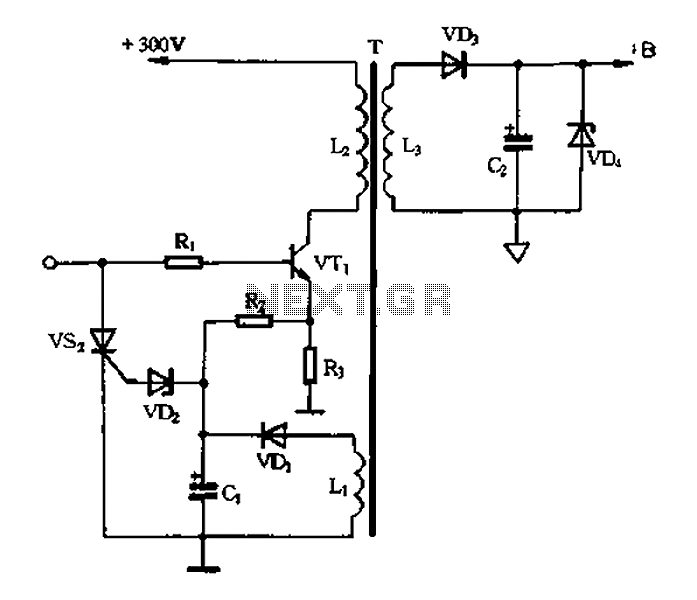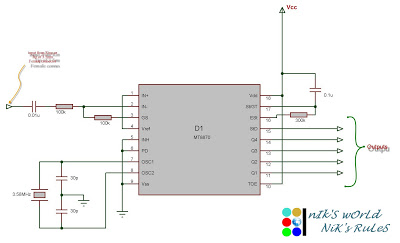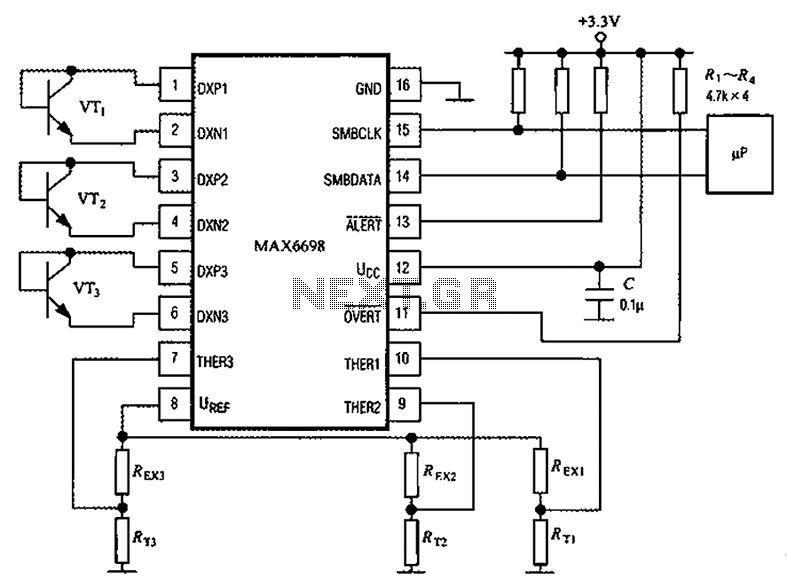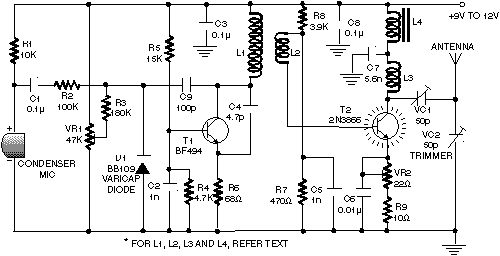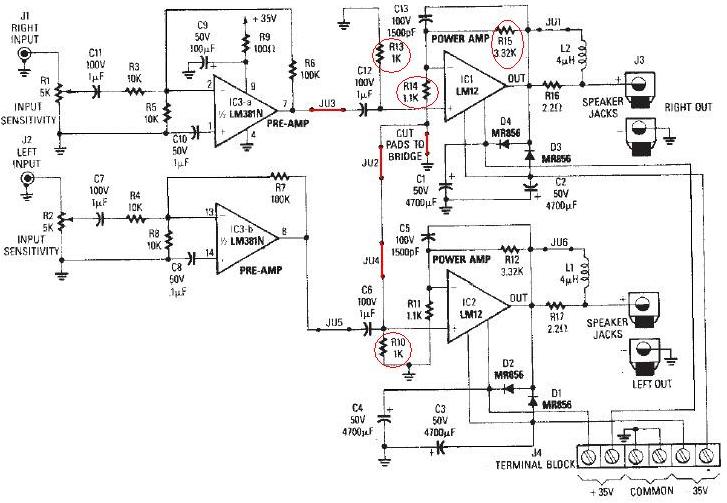
Bells Ring Generator Circuit Schematic
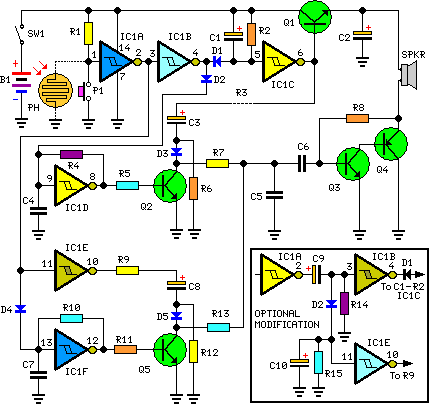
This circuit generates dual-tone bell sounds similar to those found in standard doorbell units. It is applicable in various contexts beyond doorbells. The circuit, as depicted in the diagram, produces a "Ding-tone" when switch P1 is pressed and a "Dong-tone" when it is released. The first tone frequency generator is IC1D, while IC1F is responsible for generating the second tone. Transistors Q2 and Q5, along with associated components, function as shaping and decay controls for the two tones, aiming to closely replicate the sound of bells. The outputs of these components are mixed (R7 & R13), filtered (C5), and amplified by a simple class-A audio amplifier consisting of Q3 and Q4 to drive the loudspeaker. The amplifier is activated by Q1 when P1 is pressed and is deactivated a few seconds after P1 is released, with the time delay determined by C1 and R2. This design allows the circuit to consume negligible current while in standby mode. To achieve a "Ding-Dong" operation upon pressing P1, regardless of when it is released, modifications must be made as indicated in the lower right corner of the circuit diagram. Specifically, D4 should be removed, and C10 along with R15 will set the time delay between the first and second tones. An interesting application of this circuit, wired according to the original schematic, involves using a photo-resistor in place of P1, allowing the unit to be placed near the flashing lights of a Christmas tree, producing a soft bell sound when the chosen lamp is turned on or off. For increased output power, R8, Q3, and Q4 can be replaced with an audio amplifier IC such as the LM386 or LM380. In this case, the power supply should be adjusted to 6 - 12V, and R4 and R10 should be modified to fine-tune the bell-tone frequencies.
The circuit operates using a combination of integrated circuits and transistors to produce a dual-tone sound effect. The central components include two frequency generators (IC1D and IC1F) that create distinct audio frequencies corresponding to the "Ding" and "Dong" sounds. The transistors Q2 and Q5 serve to shape these waveforms, manipulating their amplitude and decay characteristics to emulate the natural ringing of bells. The mixed output from these transistors is then processed through resistors R7 and R13, which work to blend the two tones harmoniously.
The filtering component, C5, is crucial for smoothing the output signal, ensuring that the sound produced is pleasant and bell-like without harsh artifacts. The class-A audio amplifier, constructed from Q3 and Q4, provides sufficient power to drive a loudspeaker, allowing the tones to be heard clearly. The activation of this amplifier is controlled by Q1, which engages the amplifier circuit when P1 is pressed, ensuring that the sound is produced only when desired.
The time-delay feature, managed by C1 and R2, allows the circuit to enter a low-power standby mode after the button is released, making it energy efficient. Modifications to achieve the "Ding-Dong" functionality involve careful removal of D4 and the adjustment of C10 and R15 to establish the desired timing between the two tones.
In applications where a photo-resistor is utilized, the circuit can respond to ambient light changes, providing an innovative way to integrate sound with visual elements, such as the seasonal lighting of a Christmas tree. Finally, for those seeking enhanced audio output, substituting the existing components with an integrated audio amplifier like the LM386 or LM380 can significantly improve sound levels, provided the power supply is appropriately increased and other components are adjusted to maintain the correct tone frequencies. This flexibility makes the circuit suitable for a wide range of applications beyond simple doorbell functions.This circuit generates a dual-tone bells ringing similar to most door-bell units. It can be used in many applications other than door-bell. In the Notes below several options will be given in order to suit different needs. The circuit as shown in the diagram generates a "Ding-tone" when P1 is pressed and a "Dong-tone" when P1 is released. IC1D is the first-tone frequency generator and IC1F generates the second-tone. Q2, Q5 and related components act as shape and decay controls of the two tones, trying to imitate as close as possible the bells sound. Their outputs are mixed (R7 & R13), filtered (C5) and boosted by a simple class-A audio amplifier (Q3 & Q4) in order to drive the loudspeaker.
The amplifier is switched-on by Q1 when P1 is pressed, then is switched-off some seconds after P1 is released: this time-delay is fixed by C1 & R2. In this way the circuit will draw a negligible current when in stand-by mode. To obtain a "Ding-Dong" operation when pushing on P1, no matter when it is released, you must modify the circuit as shown in the frame placed at the low-right corner of the circuit diagram.
D4 must be removed. C10 & R15 set the time-delay separating first and second tone. An amusing application of this circuit wired as in the original schematic, is to use a photo-resistor in place of P1, then placing the unit near the flashing lamps of your Christmas tree. A soft bell sound may be heard at switch-on and switch-off of the lamp chosen. To obtain higher output power you may substitute R8, Q3 & Q4 with an audio amplifier IC like the LM386 or LM380.
In this case power supply must be raised to 6 - 12V but at the same time R4 & R10 should be changed to adjust bell-tone frequencies. 🔗 External reference
The circuit operates using a combination of integrated circuits and transistors to produce a dual-tone sound effect. The central components include two frequency generators (IC1D and IC1F) that create distinct audio frequencies corresponding to the "Ding" and "Dong" sounds. The transistors Q2 and Q5 serve to shape these waveforms, manipulating their amplitude and decay characteristics to emulate the natural ringing of bells. The mixed output from these transistors is then processed through resistors R7 and R13, which work to blend the two tones harmoniously.
The filtering component, C5, is crucial for smoothing the output signal, ensuring that the sound produced is pleasant and bell-like without harsh artifacts. The class-A audio amplifier, constructed from Q3 and Q4, provides sufficient power to drive a loudspeaker, allowing the tones to be heard clearly. The activation of this amplifier is controlled by Q1, which engages the amplifier circuit when P1 is pressed, ensuring that the sound is produced only when desired.
The time-delay feature, managed by C1 and R2, allows the circuit to enter a low-power standby mode after the button is released, making it energy efficient. Modifications to achieve the "Ding-Dong" functionality involve careful removal of D4 and the adjustment of C10 and R15 to establish the desired timing between the two tones.
In applications where a photo-resistor is utilized, the circuit can respond to ambient light changes, providing an innovative way to integrate sound with visual elements, such as the seasonal lighting of a Christmas tree. Finally, for those seeking enhanced audio output, substituting the existing components with an integrated audio amplifier like the LM386 or LM380 can significantly improve sound levels, provided the power supply is appropriately increased and other components are adjusted to maintain the correct tone frequencies. This flexibility makes the circuit suitable for a wide range of applications beyond simple doorbell functions.This circuit generates a dual-tone bells ringing similar to most door-bell units. It can be used in many applications other than door-bell. In the Notes below several options will be given in order to suit different needs. The circuit as shown in the diagram generates a "Ding-tone" when P1 is pressed and a "Dong-tone" when P1 is released. IC1D is the first-tone frequency generator and IC1F generates the second-tone. Q2, Q5 and related components act as shape and decay controls of the two tones, trying to imitate as close as possible the bells sound. Their outputs are mixed (R7 & R13), filtered (C5) and boosted by a simple class-A audio amplifier (Q3 & Q4) in order to drive the loudspeaker.
The amplifier is switched-on by Q1 when P1 is pressed, then is switched-off some seconds after P1 is released: this time-delay is fixed by C1 & R2. In this way the circuit will draw a negligible current when in stand-by mode. To obtain a "Ding-Dong" operation when pushing on P1, no matter when it is released, you must modify the circuit as shown in the frame placed at the low-right corner of the circuit diagram.
D4 must be removed. C10 & R15 set the time-delay separating first and second tone. An amusing application of this circuit wired as in the original schematic, is to use a photo-resistor in place of P1, then placing the unit near the flashing lamps of your Christmas tree. A soft bell sound may be heard at switch-on and switch-off of the lamp chosen. To obtain higher output power you may substitute R8, Q3 & Q4 with an audio amplifier IC like the LM386 or LM380.
In this case power supply must be raised to 6 - 12V but at the same time R4 & R10 should be changed to adjust bell-tone frequencies. 🔗 External reference
Warning: include(partials/cookie-banner.php): Failed to open stream: Permission denied in /var/www/html/nextgr/view-circuit.php on line 713
Warning: include(): Failed opening 'partials/cookie-banner.php' for inclusion (include_path='.:/usr/share/php') in /var/www/html/nextgr/view-circuit.php on line 713

